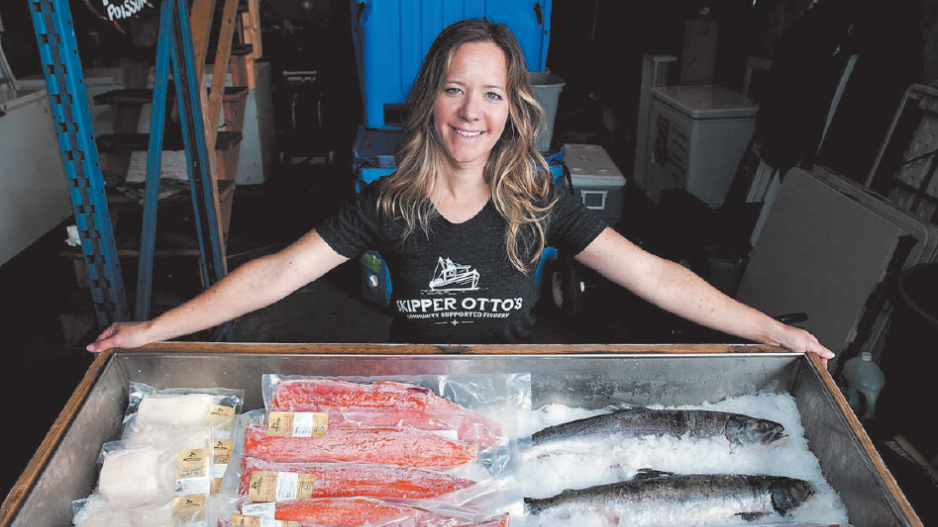Seven years ago, when it had become apparent that the Fraser River gillnet fishery was fast losing the ability to provide full-time work, Otto Strobel, 74, decided it was time to pack it in and pull in his nets for good.
His son, Shaun Strobel, had already quit fishing to become a teacher. The commercial fishery had been hammered over the years by limited openings or – in some years – no openings at all, while costs continued to increase. Even when there was an opening, the prices set by wholesalers didn’t cover the input.
“He was losing money,” Sonia Strobel said of her father-in-law. “He was going to give up fishing because of that. We felt that that was really a very sad reality – that an independent fisherman of his age who wanted to keep fishing couldn’t keep fishing.”
But Otto Strobel is still fishing, and his son is back on the water, too.
It wasn’t just the unexpected bounty of massive returns of Fraser River sockeye in 2010 and 2014 that has kept them afloat, although that didn’t hurt.
What is making fishing more viable for them and 18 other commercial fishermen is a different sales model, one that cuts out the middlemen – the wholesalers and processors – and lets fishermen sell directly to customers.
Skipper Otto’s Community Supported Fishery is a subscription based business in which subscribers buy shares and can reserve portions of the catch directly from commercial fishermen.
Founded in 2008 by Sonia and Shaun Strobel with just 40 subscribers and one boat, it now has 1,500 subscribers and 20 fishermen-suppliers.
Initially, the direct sales model was simply intended to help Otto Strobel survive, and Sonia Strobel, who was a teacher, helped run the business in her spare time.
But it has since grown by word of mouth into a full-scale business, with three full-time employees and three seasonal employees. Last year, Sonia Strobel quit teaching to run the business full-time.
“We originally started it just as a way to keep fishing in our family,” she said. “But it’s now exploded.”
The company’s 1,500 subscribers buy shares in $100 increments. They get email alerts when a boat is coming in with a load of salmon, halibut, tuna, prawns, Dungeness crab or ling cod. They can place an order online to reserve as much seafood as they want, then pick it up as soon as it comes in at one of five locations in the Lower Mainland.
The business was born of necessity.
“My husband, who grew up fishing, came to realize that the conventional seafood supply chain meant that it wasn’t really possible for independent fishermen to make a living wage,” Sonia Strobel said.
The price commercial fishermen get for their catch is set by the large wholesalers and processors. Earlier in the season, they may pay the same price that Skipper Otto’s pays. But as the season progresses and more fish flood the market – including sockeye from Alaska – those prices can drop sharply.
Skipper Otto’s doesn’t drop the price it pays to its fishermen. It also covers their Canada Pension Plan and employment insurance premiums.
“We guarantee the fishermen that stable price,” Sonia Strobel said. “We guarantee them $3 per pound for sockeye salmon. And we do the same thing with all the other species. We pay them a higher price and we also pay them all of their benefits.”
“If I got $1.50 [from a wholesaler] for sockeye, Shaun would pay something like $2.50,” said Stewart McDonald, one of the 20 fishermen-suppliers. “It’s a lot more.”
When he first heard about Skipper Otto’s, McDonald said, he was skeptical that it would work as a business.
“I thought, ‘Who’s going to buy fish up front? Why not just go to the store?’”
Karole Sutherland, who has been a Skipper Otto’s member from the beginning, said there are several reasons she prefers to get her fish directly from fishermen.
For one, she likes the idea of supporting local farmers and fishermen. And, she said, the price she pays is comparable to what she would pay in grocery stores. What’s not comparable is how fresh the seafood is when it comes right off the boat.
As she points out, even salmon bought right off the boat in Steveston is usually flash-frozen.
“Unless you go out and catch it yourself, you’re always getting frozen salmon,” she said.
One of the things McDonald likes about Skipper Otto’s is the interaction between fishermen and customers, who are eager to learn about the commercial fishery.
“People are really interested in how stuff is caught, who catches it, and the supply chain or how the fishery has openings and who gets to catch it and why,” he said. “It’s partly the foodie thing – people want the best products, and a lot of people want to meet the fishermen and talk to them.”
Currently, McDonald still sells to wholesalers. Skipper Otto’s makes up a small portion of his sales, although he thinks there is potential for growth.
“I do it because I like it, but I do make a little extra money,” he said. “And I can see the growth in Shaun. He gets bigger, he’ll buy more fish. It’s better for me.”
Sonia Strobel said Skipper Otto’s is part of a growing trend. There are now dozens of community-supported fisheries, including in New York City.
Recently, Skipper Otto’s has branched out beyond B.C., partnering with distributors in Saskatchewan and Alberta. •




